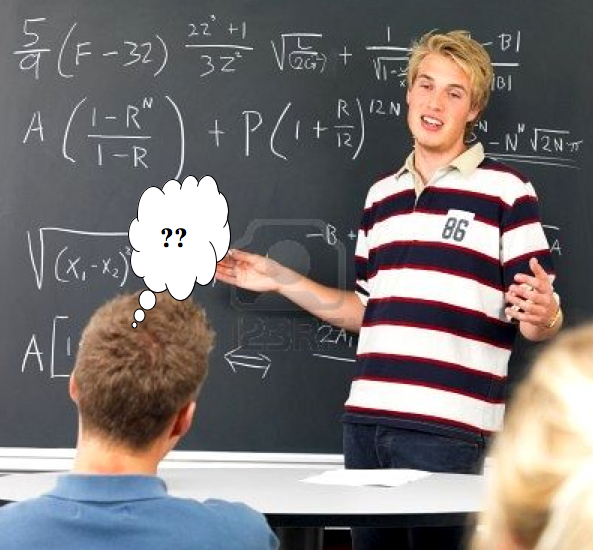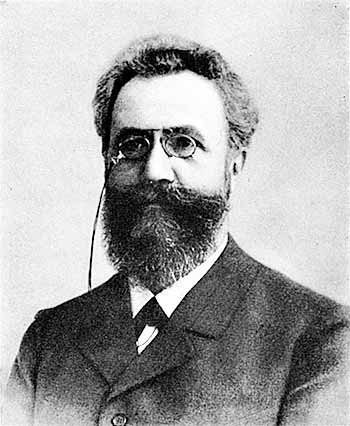Should students memorize the quadratic formula?
Posted by: Gary Ernest Davis on: November 26, 2010
 Recently, Dan Meyer @ddmeyer Tweeted:
Recently, Dan Meyer @ddmeyer Tweeted:
x
x
x
The quadratic formula
Rote memorization
This is about a useless a technique as was ever thought of for educational purposes, yet it is trotted out often by teachers: “Why won’t they just rote memorize it?”
What this concern betrays, in my experience, is a lack of understanding of human memory systems – the aspect of brain functioning that is critical to education.
The definitive study on rote memorization was done by Hermann Ebbinghaus and published in 1885. He studied the rate of learning and forgetting of nonsense syllables by himself, and formulated his law of forgetting in which an exponential decay describes the rate at which rote memorized information is lost.
One might argue that mathematical terminology, facts, procedures, and formulas are not nonsense syllables, having a great deal of logical structure.
This argument misses the point that to many students the mathematics they are expected to remember appears to them to be more or less nonsense syllables, devoid of any real meaning.
Mathematical experience is not, for these students, something that they can fit into a broader scheme of related memories.
As a result their knowledge decays exponentially and, as experience shows, with a quite small half-life.
Rote memorization decays exponentially and we can only safely rely on recall of something rote-memorized if it is continually practiced and refreshed.
Permastore memory
Harry Bahrick studies very long term memory.
Here’s what he had to say about long term memory and education in the Oxford Handbook of Memory:
“Educators have emphasized the immediate achievements of students, paying little attention to the effects of their instruction on long-term retention of content.”
His research has unearthed a number of important issues:
- Instructional techniques that favor rapid learning may yield poor retention.
- Spaced rehearsals can dramatically enhance accessibility of even marginal content for long periods of time.
- Content that is not frequently accessed (e.g. mathematics) could remain accessible by implementing brief appropriately spaced retrieval practice sessions.
The major lessons for mathematics teachers that result from Bahrick’s research are that focusing on rapid achievement is likely to inhibit longer term retention. Practicing recall of earlier learned material at spaced intervals can dramatically increase longer term recall.
Schema
Theory of quadratic equations
How “should” a student solve quadratic equations?
- Divide by the coefficient of
. This gives us the equation
- Move the constant term to the other side of the equation:
- Add as much to both sides of the equation as is needed to make the left side a perfect square:
- Re-write the equation as a perfect square equals a constant:
- Recognize there are solutions if the right side of this equation is not negative:
- Take square roots:
(remembering that a number and its negative square to the same result)
- Rearrange to find the solutions:
- Make things a little simpler if possible:
Postscript
- We multiply through by
to get
- Recognize this as
- Rewrite as
- Take square roots to get
- Rearrange to get
- Simplify if possible:
10 Responses to "Should students memorize the quadratic formula?"
[…] This post was mentioned on Twitter by Paige Graiser, Republic of Math. Republic of Math said: Should students memorize the #quadratic formula? http://wp.me/pJESd-Ul @ddmeyer #math #algebra […]
The answer to how to teach students the solution to a quadratic formula is to INCLUDE the visual interpretation of Completing the Square; not just show symbols without a picture. If the visual part is missing, then the student must memorize which term to introduce during the algebraic steps; if the visual part is included, then memorization becomes unnecessary, and the term to introduce becomes easy to obtain. Remember, when we complete the square, we not only ADD the new term, but we also SUBTRACT it, and by doing so, we solve the original equation. The term which completes the square simply gives us a way to factor an expression. The algebra steps are actually very easy and a student could solve a quadratic equation generally, by himself, and actual memorization is not immediately necessary. He can still learn to memorize the solution when he practices and sees the solution enough.
I did not include any link to this visual solution process for Completing the Square but one should be easy enough to find.
Thanks for your comment.
I did think about the completing the square visual. As much as I favor visual explanations I decided against it, because it raised for me the issue of positive and negative numbers: what visual interpretation do we have for a side length of -3, that makes sense for a student at this stage of their education? I can recall even as a student rapidly ditching the visual introduction to completing the square for this reason.On the other hand, it may work very well for some, or even most, students. I don’t know.
To be honest I don’t think that the curriculum matters that much. Students memorize the quadratic formula and they apply the steps without understanding. If you take the quadratic formula away, then they will memorize the steps for completing the square and apply them without understanding.
I think that the problem is that many students are insecure about mathematics, so they cling to ineffective strategies such as rote memorization. It’s easy to blame the teachers, but I think that it’s a cultural problem. Our culture believes that you need a special kind of mind to excel at math. If you are struggling with math, then you probably aren’t a “math person”. I think that we have to break this cultural belief before we can truly reform math education.
Thanks for this comment. It addresses a couple of issues that I would like to take up in a later post.
I see the same thing in general with my algebra students. Middle school teaches them so many “tricks” and formulas, that all creativity has been leeched out. Almost all responses in the beginning of the year are, “I remember something about how to do this…”.
My general pet peeve is when they say undefined for infinite slope yet have no idea what that means.
I liken this to the Simpson’s episode in which the following dialog takes place:
Mrs. Krabappel: Now whose calculator can tell me what 7 times 8 is?
Milhouse: Oh! Oh! Oh! “Low battery?â€
Mrs. Krabappel [sighs]: Whatever.
Phil, thanks for this comment. sadly there is a lot of truth in the Simpson’s reference.
I must say this reminds me of Lave and Wenger’s peripheral participation – minus the “legitimate” part. Students, it seems to me, are learning to participate in the “school game”. For the most part they cannot see there is a deeper game.
on my model, students know very well that there is a deeper game.
but they *also* that they will never *play* that deeper game.
it’s easy enough to teach QF… or anything else… right
*if* the students are actually willing (and time allows).
both of these conditions usually fail badly in introductory algebra.
this problem doesn’t go away with wishing though there sure
do seem to be a lot of us willing to try.
here’s my quadratic formula lore post
of a couple years ago.
Like so many others, teachers must straddle the line between theory and practice. Ideally, every student should eventually be able to derive the quadratic formula: after all, completing the square isn’t that complicated. But the reality of what you are expected to cover (as a teacher) and what you are expected to demonstrate (as a student) means that, at some point, memorization may be an appropriate strategy.
I’m ok with that, as long as I do the following (which Gary mentions in the post):
1) Teach it thoroughly before ever suggesting memorization (plenty of examples with completing the square; algebra; visuals)
2) Constantly tie the formula to new and old knowledge in order to strengthen the schema (discriminant; x-intercepts; other polynomials; number theory, etc). This is fairly easy to do here, because finding roots and zeroes is such a funamental algebraic skill.
PH



November 26, 2010 at 4:16 pm
I agree with your reasoning, but I think the formulation of your argument misses the deeper question — namely, how do we intervene with the students (mathematically) who have already been forced to memorize the quadratic formula.
This is the situation of the students in my Algebra 2 class. They arrived having already been force-fed the quadratic formula. Like little geese in the Perigord region. By the time they showed up, it had already become a conditioned response — practically a reflex. Rattle the feed can and they open their little beaks. Show them an x^2 and they spit out the quadratic formula before you can even get to a proper question.
And still worse, they cling to it as if it were a security blanket. They arrive with their mathematical confidence in tatters, and they have been convinced that this is the one algebraic thing they truly “know”– and I use that word loosely. Their memory/understanding of the formula is often quite degraded or distorted.
More and more, I am coming to believe that this is the actual problem we need to address. It would be *nice* to reconfigure the whole curriculum, but it is *urgent* that we figure out how to help these students in the here and now. I would be very interested in hearing (and discussing) how we can help these students in their actual predicament arrive at the kind of mathematical thinking you are advocating.
Elizabeth (aka @cheesemonkeysf on Twitter)